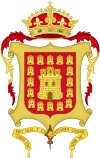Baza, Granada facts for kids
Quick facts for kids
Baza
|
|||
|---|---|---|---|
|
|||
 |
|||
| Country | |||
| Autonomous community | Andalusia | ||
| Province | Granada | ||
| Comarca | Baza | ||
| Judicial district | Baza | ||
| Founded | Between 1810 and 500 BC | ||
| Area | |||
| • Total | 545 km2 (210 sq mi) | ||
| Elevation | 844 m (2,769 ft) | ||
| Population
(2018)
|
|||
| • Total | 20,519 | ||
| • Density | 37.65/km2 (97.51/sq mi) | ||
| Demonym(s) | Bastetano, na | ||
| Time zone | UTC+1 (CET) | ||
| • Summer (DST) | UTC+2 (CEST) | ||
| Postal code |
18800
|
||
| Dialing code | (+34) 958 | ||
Baza is a town located in the province of Granada in southern Spain. It is part of the Andalusia region. Baza was once an important religious center and is now known as a Latin Catholic titular see, which means it's a former bishopric that still has a special religious title.
The town is also famous as the birthplace of David Valero, a well-known cyclist.
Contents
About Baza Today
Baza is home to about 21,000 people (as of 2003). It sits 844 meters (about 2,769 feet) above sea level. The town is in a valley called the Hoya de Baza, which is part of the Sierra Nevada mountain range. The Gallego River flows nearby.
The town gives its name to the Sierra de Baza mountains. A large, dome-shaped mountain called Jabalcón can be seen overlooking Baza from the northwest. The municipality of Baza is located at the southern edge of the Altiplano de Granada, which is a high plateau.
Baza's Long History
Baza has a very rich history, with evidence of people living there for thousands of years.
Ancient Times
A very old and important statue called the Lady of Baza was found here on July 22, 1971. This shows how ancient the area is. The city itself was started by the Iberians around the 4th century BC. They called it Basti.
Later, when the Romans took over, it was still known as Basti. It became an important trading hub in the Roman province of Tarraco. It was also one of the first places to have a Christian bishop.
Under Islamic Rule
When the Moors ruled Spain, Baza became a key border town next to the kingdom of Murcia. It was a major center for trade and had a large population, sometimes more than 50,000 people. This made it one of the most important cities in the Kingdom of Granada.
During the time of Islamic rule (from 713 to 1489), the main church, which was built around 600 by the Visigoth king Reccared, was changed into a mosque. The area's bishopric (the region managed by a bishop) stopped existing for a while.
In the 11th century, a Jewish community lived in Baza. An old Jewish ritual bath, called a mikveh, was found where the old Jewish neighborhood used to be.
After the Reconquista
In 1489, during the Granada War, Queen Isabella I of Castile captured Baza. The city fought hard for seven months before it fell. You can still see old cannons from this time in the Alameda park.
Later, on August 10, 1810, during the Napoleonic Wars, French forces led by Marshal Nicolas Jean de Dieu Soult defeated a large Spanish army near the town.
Religious History
The bishopric of Basti existed as early as 306 AD. Its bishop, Eutychianus, attended an important church meeting called the Council of Elvira. Other bishops from Basti also took part in various Councils of Toledo. The main church was founded by the Visigoth king Reccared around 600 AD. Its original location is now where the old church of San Máximo stands.
After the Moorish conquest, the bishopric was stopped in the 8th century, and the main church became a mosque. However, it was brought back in 1306.
After the Reconquista (when Christian kingdoms retook Spain), the areas of Basti and Acci were combined on May 21, 1492. This formed the modern Diocese of Guadix. A special church, the Colegiata de Nuestra Señora Santa María de la Encarnación, Baza, was set up in Baza.
To make things work, the church in Baza was given authority over twelve parishes under the bishop. The bishopric was even called the Diocese of Guadix-Baza for a while, showing it was a union of two areas. This continued until 1851.
Today, the former main church of Our Lady of the Incarnation in Baza is still very important. It was rebuilt on the site of the old mosque. It now serves as a co-cathedral for the Diocese of Guadix-Baza, sharing its status with the main cathedral in Guadix.
Getting Around Baza
Baza used to have a railway station until 1985. This railway line, called the Ferrocarril del Almanzora, connected Murcia to Granada. There are talks about reopening this important train line.
The northern part of the A-92 highway also runs right next to the town, making it easy to travel by car.
See also
 In Spanish: Baza (Granada) para niños
In Spanish: Baza (Granada) para niños






